Bing Liu
Jack
Remote Labor Index: Measuring AI Automation of Remote Work
Oct 30, 2025Abstract:AIs have made rapid progress on research-oriented benchmarks of knowledge and reasoning, but it remains unclear how these gains translate into economic value and automation. To measure this, we introduce the Remote Labor Index (RLI), a broadly multi-sector benchmark comprising real-world, economically valuable projects designed to evaluate end-to-end agent performance in practical settings. AI agents perform near the floor on RLI, with the highest-performing agent achieving an automation rate of 2.5%. These results help ground discussions of AI automation in empirical evidence, setting a common basis for tracking AI impacts and enabling stakeholders to proactively navigate AI-driven labor automation.
Beyond Seeing: Evaluating Multimodal LLMs on Tool-Enabled Image Perception, Transformation, and Reasoning
Oct 14, 2025Abstract:Multimodal Large Language Models (MLLMs) are increasingly applied in real-world scenarios where user-provided images are often imperfect, requiring active image manipulations such as cropping, editing, or enhancement to uncover salient visual cues. Beyond static visual perception, MLLMs must also think with images: dynamically transforming visual content and integrating it with other tools to solve complex tasks. However, this shift from treating vision as passive context to a manipulable cognitive workspace remains underexplored. Most existing benchmarks still follow a think about images paradigm, where images are regarded as static inputs. To address this gap, we introduce IRIS, an Interactive Reasoning with Images and Systems that evaluates MLLMs' ability to perceive, transform, and reason across complex visual-textual tasks under the think with images paradigm. IRIS comprises 1,204 challenging, open-ended vision tasks (603 single-turn, 601 multi-turn) spanning across five diverse domains, each paired with detailed rubrics to enable systematic evaluation. Our evaluation shows that current MLLMs struggle with tasks requiring effective integration of vision and general-purpose tools. Even the strongest model (GPT-5-think) reaches only 18.68% pass rate. We further observe divergent tool-use behaviors, with OpenAI models benefiting from diverse image manipulations while Gemini-2.5-pro shows no improvement. By introducing the first benchmark centered on think with images, IRIS offers critical insights for advancing visual intelligence in MLLMs.
Rubrics as Rewards: Reinforcement Learning Beyond Verifiable Domains
Jul 23, 2025
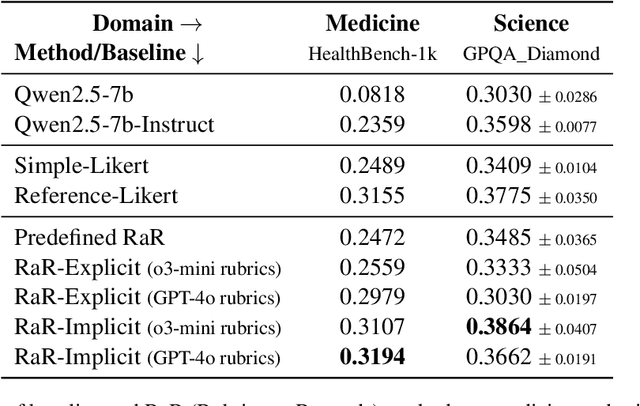
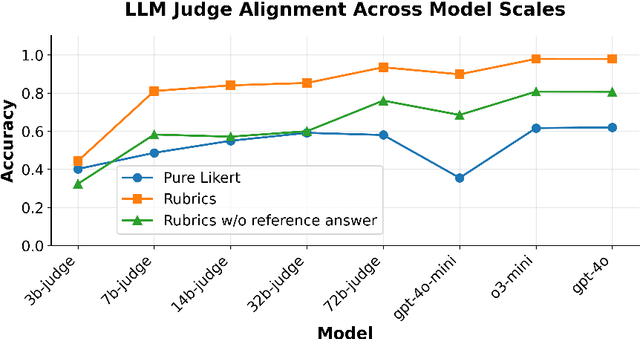
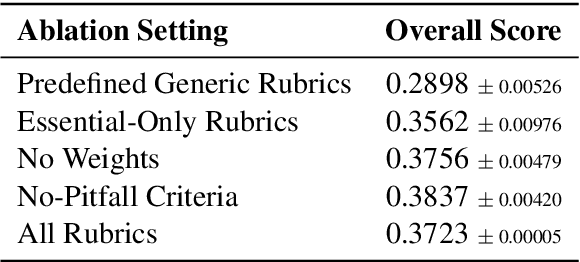
Abstract:Extending Reinforcement Learning with Verifiable Rewards (RLVR) to real-world tasks often requires balancing objective and subjective evaluation criteria. However, many such tasks lack a single, unambiguous ground truth-making it difficult to define reliable reward signals for post-training language models. While traditional preference-based methods offer a workaround, they rely on opaque reward functions that are difficult to interpret and prone to spurious correlations. We introduce $\textbf{Rubrics as Rewards}$ (RaR), a framework that uses structured, checklist-style rubrics as interpretable reward signals for on-policy training with GRPO. Our best RaR method yields up to a $28\%$ relative improvement on HealthBench-1k compared to simple Likert-based approaches, while matching or surpassing the performance of reward signals derived from expert-written references. By treating rubrics as structured reward signals, we show that RaR enables smaller-scale judge models to better align with human preferences and sustain robust performance across model scales.
MultiNRC: A Challenging and Native Multilingual Reasoning Evaluation Benchmark for LLMs
Jul 23, 2025Abstract:Although recent Large Language Models (LLMs) have shown rapid improvement on reasoning benchmarks in English, the evaluation of such LLMs' multilingual reasoning capability across diverse languages and cultural contexts remains limited. Existing multilingual reasoning benchmarks are typically constructed by translating existing English reasoning benchmarks, biasing these benchmarks towards reasoning problems with context in English language/cultures. In this work, we introduce the Multilingual Native Reasoning Challenge (MultiNRC), a benchmark designed to assess LLMs on more than 1,000 native, linguistic and culturally grounded reasoning questions written by native speakers in French, Spanish, and Chinese. MultiNRC covers four core reasoning categories: language-specific linguistic reasoning, wordplay & riddles, cultural/tradition reasoning, and math reasoning with cultural relevance. For cultural/tradition reasoning and math reasoning with cultural relevance, we also provide English equivalent translations of the multilingual questions by manual translation from native speakers fluent in English. This set of English equivalents can provide a direct comparison of LLM reasoning capacity in other languages vs. English on the same reasoning questions. We systematically evaluate current 14 leading LLMs covering most LLM families on MultiNRC and its English equivalent set. The results show that (1) current LLMs are still not good at native multilingual reasoning, with none scoring above 50% on MultiNRC; (2) LLMs exhibit distinct strengths and weaknesses in handling linguistic, cultural, and logical reasoning tasks; (3) Most models perform substantially better in math reasoning in English compared to in original languages (+10%), indicating persistent challenges with culturally grounded knowledge.
ImprovDML: Improved Trade-off in Private Byzantine-Resilient Distributed Machine Learning
Jun 18, 2025Abstract:Jointly addressing Byzantine attacks and privacy leakage in distributed machine learning (DML) has become an important issue. A common strategy involves integrating Byzantine-resilient aggregation rules with differential privacy mechanisms. However, the incorporation of these techniques often results in a significant degradation in model accuracy. To address this issue, we propose a decentralized DML framework, named ImprovDML, that achieves high model accuracy while simultaneously ensuring privacy preservation and resilience to Byzantine attacks. The framework leverages a kind of resilient vector consensus algorithms that can compute a point within the normal (non-Byzantine) agents' convex hull for resilient aggregation at each iteration. Then, multivariate Gaussian noises are introduced to the gradients for privacy preservation. We provide convergence guarantees and derive asymptotic learning error bounds under non-convex settings, which are tighter than those reported in existing works. For the privacy analysis, we adopt the notion of concentrated geo-privacy, which quantifies privacy preservation based on the Euclidean distance between inputs. We demonstrate that it enables an improved trade-off between privacy preservation and model accuracy compared to differential privacy. Finally, numerical simulations validate our theoretical results.
Learning Knowledge-based Prompts for Robust 3D Mask Presentation Attack Detection
May 06, 2025Abstract:3D mask presentation attack detection is crucial for protecting face recognition systems against the rising threat of 3D mask attacks. While most existing methods utilize multimodal features or remote photoplethysmography (rPPG) signals to distinguish between real faces and 3D masks, they face significant challenges, such as the high costs associated with multimodal sensors and limited generalization ability. Detection-related text descriptions offer concise, universal information and are cost-effective to obtain. However, the potential of vision-language multimodal features for 3D mask presentation attack detection remains unexplored. In this paper, we propose a novel knowledge-based prompt learning framework to explore the strong generalization capability of vision-language models for 3D mask presentation attack detection. Specifically, our approach incorporates entities and triples from knowledge graphs into the prompt learning process, generating fine-grained, task-specific explicit prompts that effectively harness the knowledge embedded in pre-trained vision-language models. Furthermore, considering different input images may emphasize distinct knowledge graph elements, we introduce a visual-specific knowledge filter based on an attention mechanism to refine relevant elements according to the visual context. Additionally, we leverage causal graph theory insights into the prompt learning process to further enhance the generalization ability of our method. During training, a spurious correlation elimination paradigm is employed, which removes category-irrelevant local image patches using guidance from knowledge-based text features, fostering the learning of generalized causal prompts that align with category-relevant local patches. Experimental results demonstrate that the proposed method achieves state-of-the-art intra- and cross-scenario detection performance on benchmark datasets.
Learning Unknown Spoof Prompts for Generalized Face Anti-Spoofing Using Only Real Face Images
May 06, 2025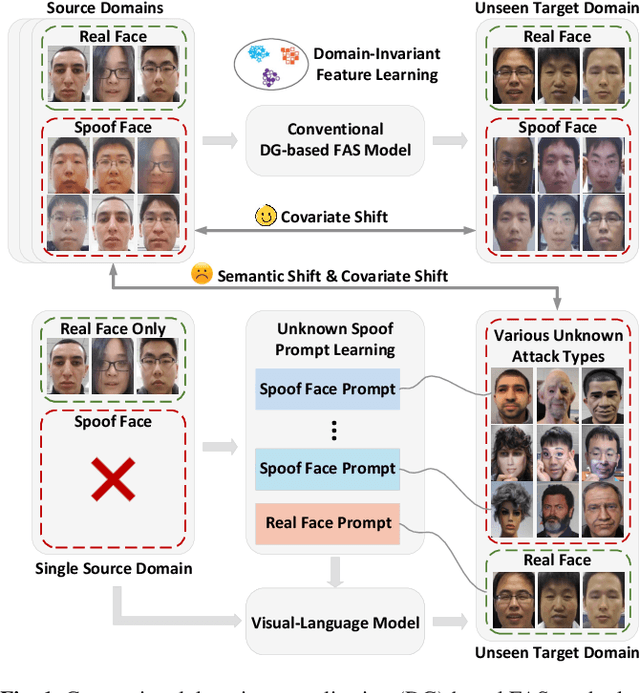
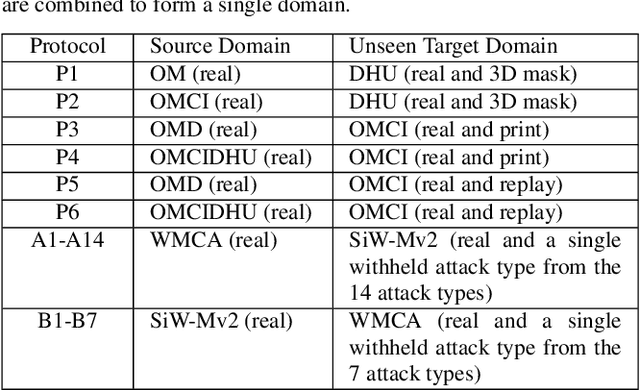
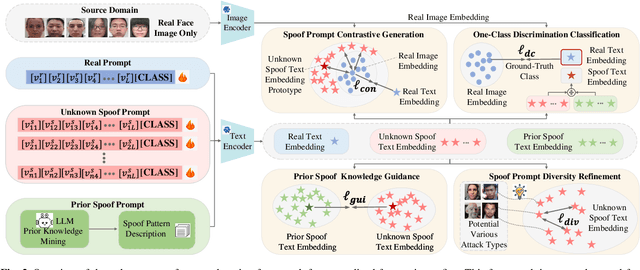
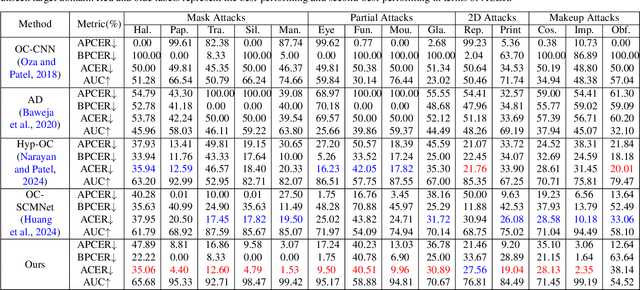
Abstract:Face anti-spoofing is a critical technology for ensuring the security of face recognition systems. However, its ability to generalize across diverse scenarios remains a significant challenge. In this paper, we attribute the limited generalization ability to two key factors: covariate shift, which arises from external data collection variations, and semantic shift, which results from substantial differences in emerging attack types. To address both challenges, we propose a novel approach for learning unknown spoof prompts, relying solely on real face images from a single source domain. Our method generates textual prompts for real faces and potential unknown spoof attacks by leveraging the general knowledge embedded in vision-language models, thereby enhancing the model's ability to generalize to unseen target domains. Specifically, we introduce a diverse spoof prompt optimization framework to learn effective prompts. This framework constrains unknown spoof prompts within a relaxed prior knowledge space while maximizing their distance from real face images. Moreover, it enforces semantic independence among different spoof prompts to capture a broad range of spoof patterns. Experimental results on nine datasets demonstrate that the learned prompts effectively transfer the knowledge of vision-language models, enabling state-of-the-art generalization ability against diverse unknown attack types across unseen target domains without using any spoof face images.
Modality-Guided Dynamic Graph Fusion and Temporal Diffusion for Self-Supervised RGB-T Tracking
May 06, 2025Abstract:To reduce the reliance on large-scale annotations, self-supervised RGB-T tracking approaches have garnered significant attention. However, the omission of the object region by erroneous pseudo-label or the introduction of background noise affects the efficiency of modality fusion, while pseudo-label noise triggered by similar object noise can further affect the tracking performance. In this paper, we propose GDSTrack, a novel approach that introduces dynamic graph fusion and temporal diffusion to address the above challenges in self-supervised RGB-T tracking. GDSTrack dynamically fuses the modalities of neighboring frames, treats them as distractor noise, and leverages the denoising capability of a generative model. Specifically, by constructing an adjacency matrix via an Adjacency Matrix Generator (AMG), the proposed Modality-guided Dynamic Graph Fusion (MDGF) module uses a dynamic adjacency matrix to guide graph attention, focusing on and fusing the object's coherent regions. Temporal Graph-Informed Diffusion (TGID) models MDGF features from neighboring frames as interference, and thus improving robustness against similar-object noise. Extensive experiments conducted on four public RGB-T tracking datasets demonstrate that GDSTrack outperforms the existing state-of-the-art methods. The source code is available at https://github.com/LiShenglana/GDSTrack.
Achieving Upper Bound Accuracy of Joint Training in Continual Learning
Feb 17, 2025Abstract:Continual learning has been an active research area in machine learning, focusing on incrementally learning a sequence of tasks. A key challenge is catastrophic forgetting (CF), and most research efforts have been directed toward mitigating this issue. However, a significant gap remains between the accuracy achieved by state-of-the-art continual learning algorithms and the ideal or upper-bound accuracy achieved by training all tasks together jointly. This gap has hindered or even prevented the adoption of continual learning in applications, as accuracy is often of paramount importance. Recently, another challenge, termed inter-task class separation (ICS), was also identified, which spurred a theoretical study into principled approaches for solving continual learning. Further research has shown that by leveraging the theory and the power of large foundation models, it is now possible to achieve upper-bound accuracy, which has been empirically validated using both text and image classification datasets. Continual learning is now ready for real-life applications. This paper surveys the main research leading to this achievement, justifies the approach both intuitively and from neuroscience research, and discusses insights gained.
Continual Learning Using a Kernel-Based Method Over Foundation Models
Dec 20, 2024Abstract:Continual learning (CL) learns a sequence of tasks incrementally. This paper studies the challenging CL setting of class-incremental learning (CIL). CIL has two key challenges: catastrophic forgetting (CF) and inter-task class separation (ICS). Despite numerous proposed methods, these issues remain persistent obstacles. This paper proposes a novel CIL method, called Kernel Linear Discriminant Analysis (KLDA), that can effectively avoid CF and ICS problems. It leverages only the powerful features learned in a foundation model (FM). However, directly using these features proves suboptimal. To address this, KLDA incorporates the Radial Basis Function (RBF) kernel and its Random Fourier Features (RFF) to enhance the feature representations from the FM, leading to improved performance. When a new task arrives, KLDA computes only the mean for each class in the task and updates a shared covariance matrix for all learned classes based on the kernelized features. Classification is performed using Linear Discriminant Analysis. Our empirical evaluation using text and image classification datasets demonstrates that KLDA significantly outperforms baselines. Remarkably, without relying on replay data, KLDA achieves accuracy comparable to joint training of all classes, which is considered the upper bound for CIL performance. The KLDA code is available at https://github.com/salehmomeni/klda.
 Add to Chrome
Add to Chrome Add to Firefox
Add to Firefox Add to Edge
Add to Edge